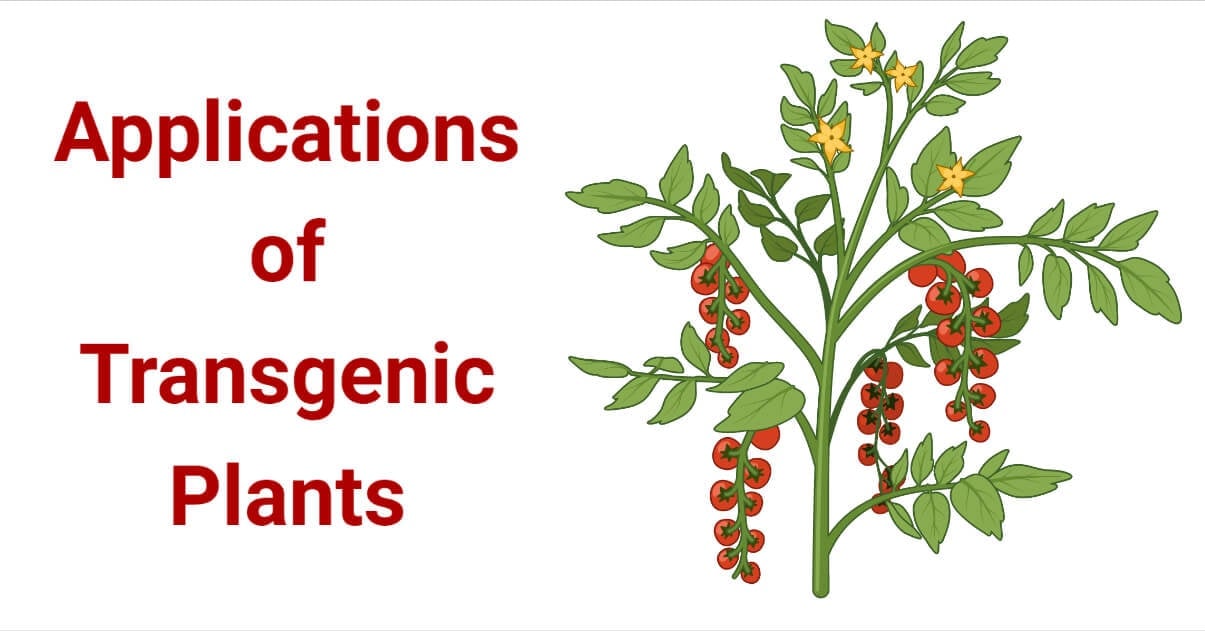The plants carry additional, stably integrated, and expressed, foreign genes from trans-species. The whole process involves the introduction, integration, and expression of foreign genes within the host by the process called genetic transformation. However, the combination of rDNA technology, certain gene transfer methods, along with tissue culture techniques have efficiently transformed which led to the production of transgenics for a wide variety of crops.

Applications of Transgenic Plants
Interesting Science Videos
Development of insect, virus, and herbicide-resistant plant
Insect resistant plants
The process of genetic engineering makes the possibility of intrinsically resistant to insects in the development of crops. This can be produced by an approach involving a gene by a subspecies of bacterium Bacillus thuringiensis which produces insecticidal protoxin. The Crop plants have been engineered to express the insecticidal toxin gene of B. thuringiensis where insects consuming plants are to be killed.
During the process of sporulation, B. thuringiensis contains an insecticidal protein called endotoxin which forms intracellular crystalline bodies. The endotoxin proteins such as Cry1, Cry2, Cry3, and others accumulate in the bacterium as inactive precursors. After ingestion by the insect, this protein is cleaved by proteases display the toxic activity, by binding to the inside of the insect’s gut and damaging the surface epithelium which results in shorter versions of the protein.
Virus resistant plants
There are many modern approaches that have been used to engineer plants such as the introduction of coat protein gene, antisense RNA approach, and ribozyme mediated protection. Among all these strategies, the exploitation of the coat protein gene has been very more prominent. Transgenic plants have a virus coat protein gene linked to a strong single promoter and this practice has been synthesized in many crop plants like tobacco, tomato, alfalfa, potato, and tobacco mosaic virus(TMV). When these plants were injected with TMV, symptoms either failed to develop or were considerably delayed. The effectiveness of the coat protein(CP) gene can be affected by both the amount of coat protein produced in transgenic plants and by the concentration of virus inoculum. Most likely, the resistance by CP occurs due to the blocking of the process of uncoating of virus particles, which is necessary for viral genome replication as well as expression. However, other effects are found to be the systemic spread of the viruses. In the latter approach, dysfunctional viral movement protein (MP) which is a transgenic expression is used to make the plant virus resistant. Resistance conferred by dysfunctional MP is caused because of competition for plasmodesmata binding sites of the inoculated virus between mutant and the wild-type MP. An interesting attribute of MP- mediated protection is the broad-spectrum efficacy.
Herbicidal resistance
Glyphosate has been engineered for resistance to herbicides such as glyphosate. Glyphosate, however, is a non-selective herbicide that inhibits 5- enolpyruvylshikimate-3 -phosphate (EPSP) synthase, used in the biosynthesis of an aromatic amino acid in plants. EPSP synthase, however, permits shikimate and phosphoenolpyruvate into 5- enolpyruvylshikimate-3 -phosphate, a precursor for the synthesis of aromatic amino acids tryptophan, tyrosine, and phenylalanine. Glyphosate competes with phosphoenolpyruvate for binding with ESPS synthase. There are two approaches that have been used to engineer resistance so that the herbicide can be used for weed control without damaging the crop. In the former approach, the target protein can be overproduced so that the resistance occurs as a consequence of having more enzymes available to the cell. The latter approach results from the expression of a mutant version of EPSP synthase that is resistant to the herbicide within the cells.
Development of Stress tolerant plant-like oxidative stress and salt stress
Modification of plant nutritional content like amino acid, lipid, vitamin, and iron. The use of genetic engineering techniques has allowed researchers to open up and develop plants with improved nutritional quality. For example, rice is extremely low in vitamin A. However, Potrykus and Beyer have developed golden rice enriched in pro-vitamin A by involving 3 genes in the biosynthetic pathway for carotenoids, the precursor for vitamin A. To obtain a functional provitamin A (beta-carotene) biosynthetic pathway, genes coding for phytoene synthase (PSY) and lycopene cyclase (Lyc) both from Narcissus pseudo cissus together with a gene coding phytoene desaturase, from bacteria were introduced. Few experiments likewise revealed that the presence of Lyc was not necessary, due to the reason that psy and crt1 somehow drive beta-carotene synthesis along with the formation of downstream xanthophylls.
Bioplastics of Production
The bacteria Alcaligenes eutrophus produce polyhydroxy butyrate (PHB), a biodegradable and renewable biopolymer. The gene from A. eutrophus that code for an enzyme responsible for the biosynthesis of PHB are being transferred to plants for the production of biodegradable plastic.
Edible Vaccines Synthesis
The gene encoding for the orally-active antigenic protein is being isolated from the pathogen, and a suitable construct for constitutive or can be tissue-specific when expression of a gene when synthesized.
The gene is introduced into the genome of selected plant species stably and expressed to produce the antigen. The required plant parts with the antigens are allowed to feed raw to humans for immunization.
The commercially made vaccines are however more expensive to produce and package along with personnel trainers to administer injections. The advantageous part would be therefore if vaccines could be delivered inexpensively on a broader scale. The process of the gene encodes an antigenic protein that is extracted from the pathogen and can be taken orally inactive form, and a suitable construct for constitutive or tissue-specific expression of the gene when obtained.
Sources
- https://sites.google.com/site/vaccinesinfo/home/edible-vaccines
- https://pubmed.ncbi.nlm.nih.gov/11880581/
- https://www.assignmenthelp.net/forum/topic/what-is-golden-rice/
- https://www.breathinglabs.com/monitoring-feed/electroporation/which-technique-is-most-commonly-used-tointroduce-genes-into-dicots-a-electroporation-b-microinjection-c-calcium-precipitation-d-ti-plasmid-infection/
- https://www.researchgate.net/publication/8209072_Transgenic_animals_in_medicine_Integration_and_expression_of_foreign_genes_theoretical_and_applied_aspects
- https://www.coursehero.com/file/phjvnmo/plants-have-been-engineered-to-contain-the-gene-for-Bt-toxin-abacterial-toxin/
- https://vdocument.in/sequences-of-the-coat-protein-gene-from-sequences-of-the-coat-protein-gene.html
- https://www.answers.com/biology/What_is_the_gene_that_codes_for_an_enzyme_needed_by_the_proteins
- https://microbewiki.kenyon.edu/index.php/Alcaligenes_Eutrophus_and_Its_Role_in_Biodegradable_Polymer_Production
